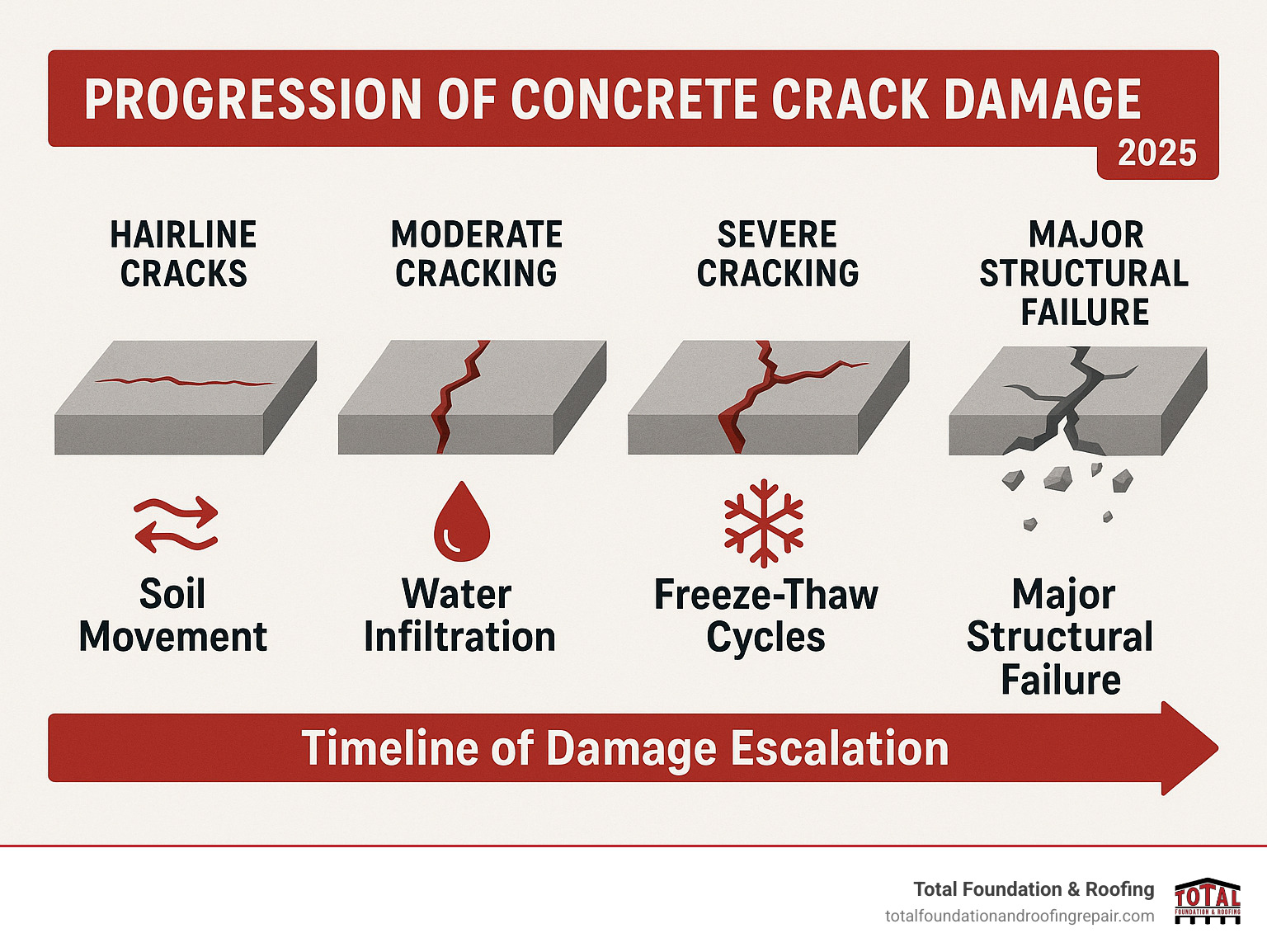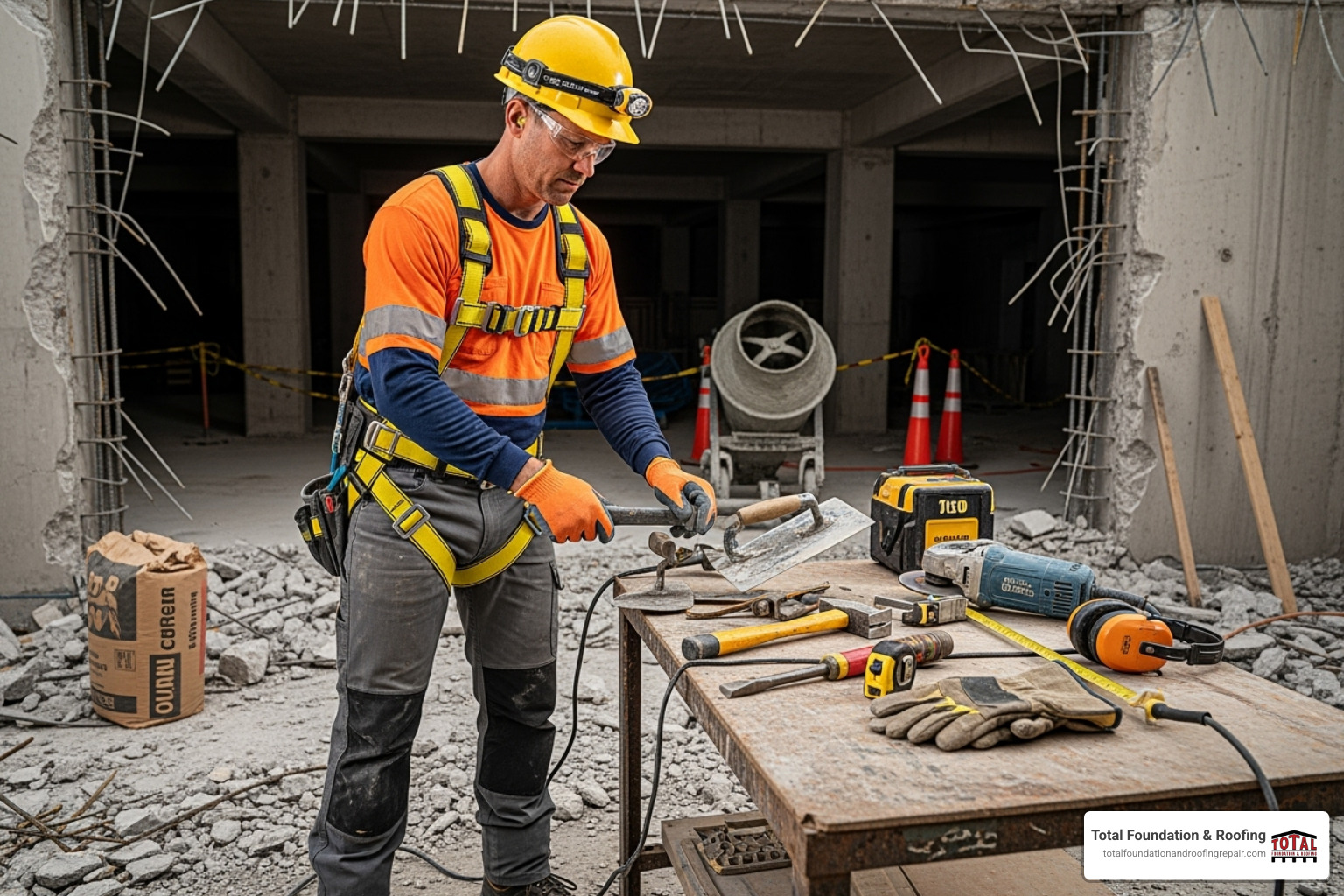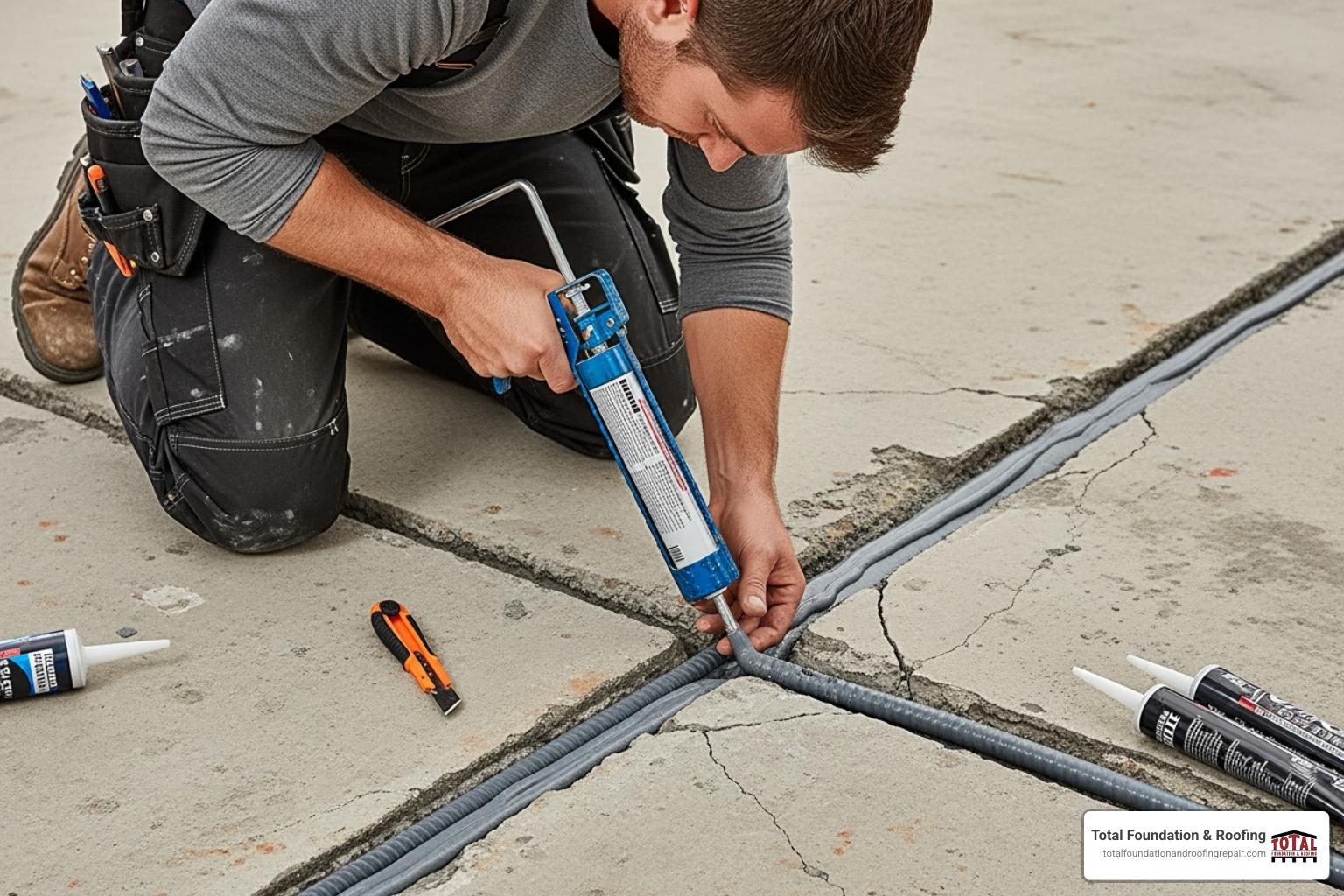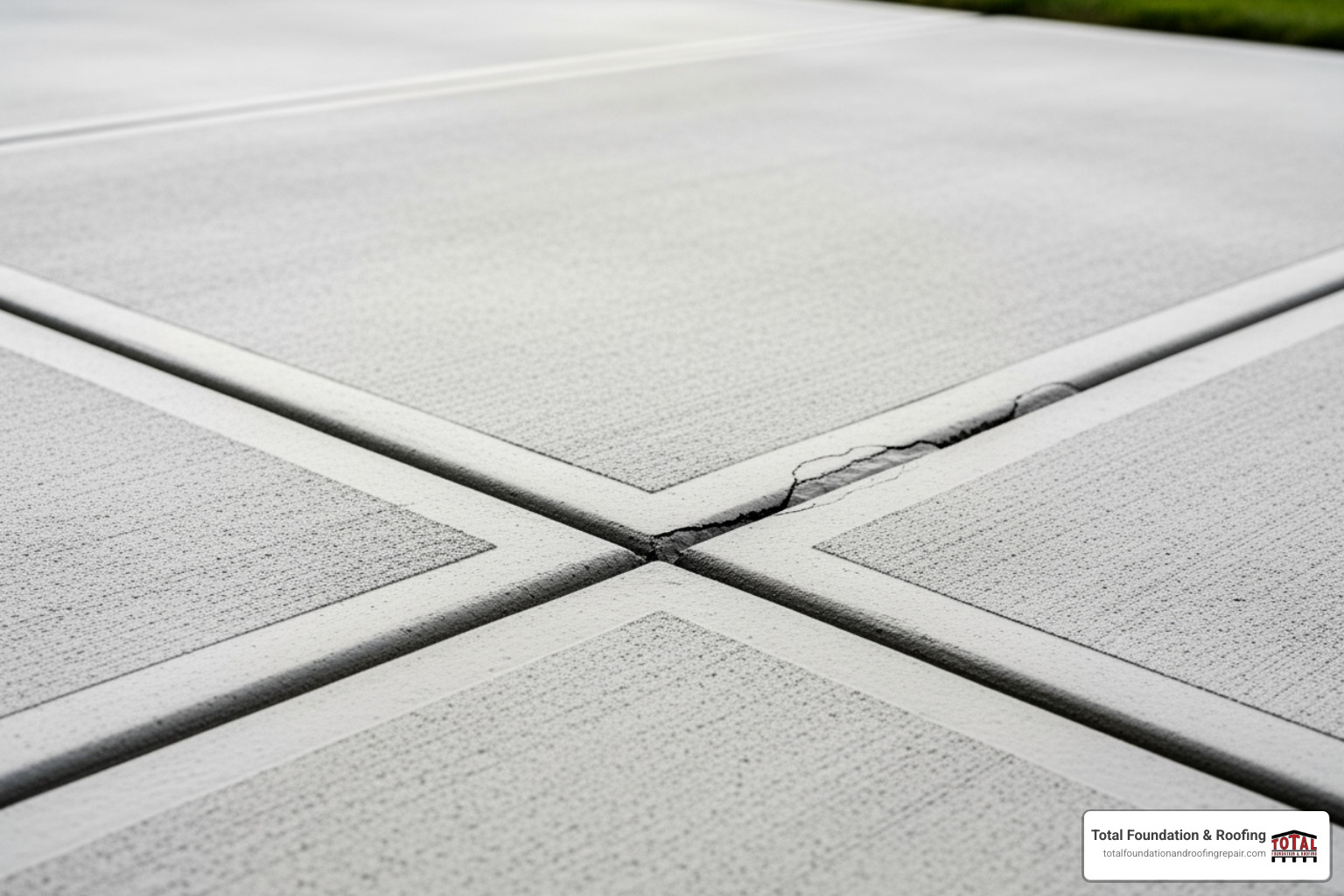Table of Contents
ToggleWhy Concrete Crack Repair Matters for Texas Homeowners
Concrete crack repair is essential for protecting your property from water damage and maintaining structural integrity. Whether it’s your driveway, patio, or foundation, addressing cracks early prevents costly future repairs. For comprehensive solutions to protect your property, explore our foundation and concrete repair services.
Quick Answer for Concrete Crack Repair:
- Narrow cracks (<1/4-inch): Use flexible crack fillers or sealants.
- Wide cracks (>1/4-inch): Install backer rod, then apply patching compound.
- Deep/structural cracks: Require professional assessment and repair.
- Surface preparation: Clean thoroughly and undercut crack edges.
- Curing time: Allow 24-48 hours before heavy use.
Concrete cracks for many reasons, from natural settling to Texas’s unique climate. Our expansive clay soils and temperature swings create movement that stresses concrete, while sudden storms can turn small cracks into major water entry points. Acting fast is key to preventing minor issues from becoming significant structural problems.
As the owner of Total Foundation & Roofing, I’ve spent over 18 years in the Texas Hill Country helping homeowners. I’ve seen how proper concrete crack repair can save thousands in potential foundation damage.

Identifying the Cause and Type of Crack
Before starting a concrete crack repair, understanding the cause is as important as the fix itself. A misdiagnosis can lead to recurring problems. Different cracks require different solutions.
Common Causes of Concrete Cracks
- Shrinkage Cracks: These are typically narrow, hairline cracks that form as new concrete cures and shrinks. They are often cosmetic.
- Settlement Cracks: Common in Texas due to our expansive clay soils, these occur when the ground shifts unevenly beneath a slab. They can range from minor to severe.
- Structural Cracks: These are serious and indicate underlying issues like poor soil compaction or significant ground movement. They often appear wide, deep, or run through the entire slab.
- Crazing: A network of fine surface cracks resembling a spider web, caused by the concrete surface drying too quickly.
What the Cracks Tell You
- Hairline Cracks (<1/4-inch): While seemingly minor, they allow water to penetrate, which can lead to larger problems over time, especially with heavy rains.
- Wide Cracks (>1/4-inch): These are a red flag for more significant issues beneath the surface. They indicate the concrete is under considerable stress.
- Uneven Slabs: If one side of a crack is higher than the other, it points to a structural problem caused by settlement or soil movement.
Repair or Replace?
Concrete crack repair is effective for most hairline cracks, isolated damage, and surface-level issues. A proper repair can extend the life of your concrete for years.
However, replacement may be necessary if you have cracks wider than an inch, multiple structural cracks, or widespread spalling (flaking or chipping). In these cases, patching is often a temporary solution that delays a more permanent fix. Being realistic about the extent of the damage is key to choosing the right approach.
Learn more about the costs of foundation crack repair.
Selecting the Best Concrete Crack Repair Products
After identifying the crack, choosing the right material is the next critical step in concrete crack repair. Modern products offer advanced solutions, but you must match the product to the problem for a lasting fix.
Understanding Your Product Options
- Epoxy Injection: This two-part resin provides incredible strength, often making the repaired area stronger than the original concrete. It’s ideal for structural cracks but is rigid, so it’s not suited for cracks that experience movement.
- Polyurethane Sealants: These are flexible and can expand and contract with the concrete, making them perfect for active cracks in driveways and patios exposed to temperature changes. Self-leveling varieties are easy to apply for a smooth finish.
- Cement-Based Patching Compounds: These polymer-modified mixes are versatile for wider cracks and spalled areas. They bond well, can be textured to match the surrounding surface, and are typically paintable.
- Liquid Crack Fillers: These acrylic or latex-based fillers are user-friendly options for hairline cracks (up to 1/4-inch). They are applied with a caulk gun and dry quickly.
Key Features in a Repair Product
- Flexibility: Essential for cracks that may move due to temperature or soil shifts. Polyurethane is a top choice for flexibility.
- Durability: Look for high strength, strong adhesion, and resistance to water and chemicals to ensure a long-lasting repair.
- Application Method: Choose a product that matches your skill level, from simple pourable fillers to those requiring specialized injection equipment.
- Curing Time: Consider how quickly you need to use the repaired area. Fast-setting products offer convenience, while slower cures can sometimes provide a stronger bond.
This table compares the most common materials:
| Feature | Epoxy Injection | Polyurethane Sealants | Cement-Based Compounds |
|---|---|---|---|
| Best For | Structural cracks, deep narrow cracks | Moving cracks, temperature-sensitive areas | Wide cracks, surface repairs, aesthetic fixes |
| Flexibility | Rigid (no movement) | Flexible (handles movement well) | Rigid to semi-flexible |
| Strength | Extremely high | Good, strong bond | Good, very durable |
| Application | Injection with specialized equipment | Cartridge gun or pour | Trowel or brush |
| Appearance | Visible unless color-matched | Can be noticeable, some paintable | Blends well, paintable |
| Waterproofing | Excellent | Excellent | Excellent |
Matching the product to your specific crack type and its underlying cause is the key to a successful repair.
Your Step-by-Step Guide to Concrete Crack Repair
With the right diagnosis and materials, you’re ready to begin the concrete crack repair. Proper preparation is the most critical part of the process, ensuring a durable, long-lasting result.

Preparation and Safety: The Keys to a Lasting Fix
Safety First: Always wear safety goggles, a dust mask or respirator, and work gloves. Concrete dust contains silica, which is harmful to inhale, and repair chemicals can irritate the skin.
Tools & Prep:
- Clean the Crack: Use a wire brush and a shop vacuum or pressure washer to remove all loose debris, dirt, and old patch material. Use a degreaser for any oil stains.
- Undercut the Edges: With a hammer and cold chisel, chip the edges of the crack to create an inverted ‘V’ shape. This “dovetail” cut mechanically locks the repair material in place, preventing it from popping out.
- Final Clean: Thoroughly vacuum or blow out all dust and debris from the prepared crack. A clean surface is essential for a strong bond.
A Practical Guide to Concrete Crack Repair

For Narrow Cracks (< 1/4-inch):
- Apply a flexible, polyurethane-based crack filler using a caulk gun.
- Squeeze the filler deep into the crack, avoiding air pockets.
- Smooth the surface with a putty knife and wipe away any excess before it sets.
For Wide Cracks (> 1/4-inch):
- Insert a foam backer rod into the crack, pushing it just below the surface. This saves material and provides a solid base.
- Mix a cement-based patching compound according to the directions.
- Press the compound firmly into the crack with a trowel, ensuring it fills the entire void.
- Smooth the surface, texturing it if desired to match the surrounding concrete.
Curing: Follow the product’s instructions for curing. Cement-based patches may need to be kept moist for 24 hours to prevent them from drying too quickly and re-cracking.
Find out more about fixing foundation cracks.
Advanced Reinforcement: The Crack Stitching System
For recurring or structural cracks, a simple fill may not be enough. Crack stitching offers a permanent structural reinforcement.
This system uses high-strength, non-corroding carbon fiber grids embedded in epoxy across the crack. This ties the concrete slabs together, preventing future movement and reopening. The installation involves cutting a shallow groove across the crack, placing the carbon fiber stitch, and filling it with epoxy. The result is an incredibly strong, invisible repair that is often stronger than the original concrete.
Crack stitching is an excellent solution for basement walls, foundations, and driveways with signs of ongoing settlement.
Learn about the technology behind advanced repairs
Explore advanced concrete crack repair solutions
Ensuring Durability and When to Call a Professional
A successful repair is one that lasts. This involves preventative maintenance and knowing when a crack signals a problem that requires a professional.

Prevention and Knowing When to Call the Pros
The best concrete crack repair is prevention. To protect your concrete and minimize future cracking, focus on these key areas:
- Ensure Proper Drainage: Water is concrete’s biggest enemy. Direct downspouts away from slabs and ensure the ground slopes away from your foundation to prevent water from pooling.
- Use Control Joints: These planned grooves in concrete encourage cracks to form in a straight, manageable line.
- Seal Your Concrete: Applying a quality concrete sealer every few years protects against water penetration, stains, and general wear.
- Manage Tree Roots: Be mindful of large trees near concrete slabs, as growing roots can exert enough force to lift and crack them.
While DIY repairs are suitable for many minor cracks, some situations demand professional expertise. Call a professional if you see:
- Cracks wider than 1/2-inch.
- Cracks that are actively growing or widening over time.
- Sinking or uneven slabs, where one side of the crack is higher than the other.
- Water actively leaking through cracks in a foundation or basement wall.
- Repetitive cracking where previous repairs have failed.
These are often symptoms of a deeper issue with your soil or foundation. Attempting to patch these without addressing the root cause will only lead to more problems. At Total Foundation & Roofing, we have the experience to diagnose these complex issues and provide a lasting solution.
If you’re facing any of these warning signs, don’t hesitate. Get a professional assessment for your foundation crack repair needs to ensure your home remains safe and stable.




